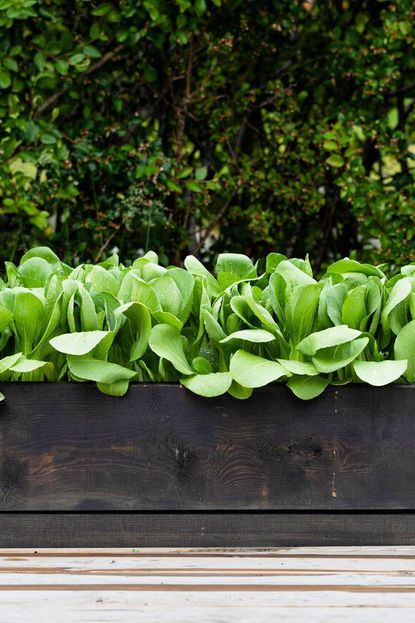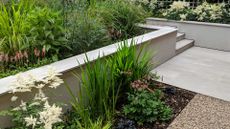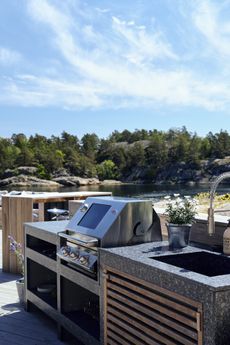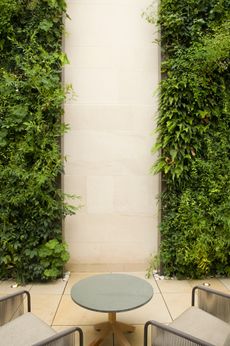Modern vegetable garden ideas: what to grow and when
Starting a modern vegetable garden in containers or raised beds? Here are the 10 things you need to grow

There are some good reasons to start a modern vegetable garden. Homegrown tastes better and is good for your wellbeing. It brings a sense of calm from planting and picking your own fresh produce and it’s the healthier option too, as you can grow things organically. And whether you want salad leaves with extra crunch, flavour packed tomatoes or fresh chillies to add a kick to your cooking, growing your own is easier than you think.
If space is tight, the trick is to grow small amounts of different crops that offer big rewards. Avoid anything high maintenance and instead opt for easy produce such as cut and come again salad leaves, chillies, dwarf varieties of French beans, leafy greens and compact tomatoes. However small your space you can squeeze in pots that will keep you going for months. Read on for our round-up of 10 of the best vegetables to get started on.
Beginning a vegetable garden with the no dig gardening method
There is a lot of appreciation for the no dig gardening method when it comes to the modern vegetable garden. Not only is it easier to start - there is far less back-breaking work to get through - it's also better for the soil. It involves cardboard, compost and raised beds, and means you won't have to be weeding your veg patch all summer long. Poppy Okotcha's expert tips for no dig gardening are a good place to start.
1 Perpetual spinach
If you have a small growing space and life is busy this is the crop for you. Try ‘Popeye’ or ‘Medania’, and eat the leaves raw for a hit of vitamins and minerals. Expect to harvest seven to eight weeks after sowing. Pick smaller leaves for the salad bowl and just remember to keep on harvesting and your plants will keep on giving. The perfect cut and come again crop, this will be prolific throughout summer and autumn and into the following year giving you a steady supply year round.

2 Dwarf French beans
A simple crop to grow that doesn’t take up much space, you’ll get dwarf beans right through summer until October. Try a cut and come again variety such as ‘Speedy’ and the plant will keep on replenishing. Available in dark purple and yellow varieties as well as green, dwarf French beans love a container and grow to a dinky 40-60cm in height. They don’t need a bamboo wigwam either as they’re self-supporting. Even better they’re stringless so less prep for you in the kitchen.

3 Tomatoes
Choose a reliable variety such as ribbed ‘Costoluto Fiorentino’, a medium-sized, Italian tomato that grows well here in a sheltered south facing spot and looks good too. Sow indoors in March, then transfer to larger pots on a well-lit windowsill, gradually acclimatising them to outdoor conditions before planting out in early summer. If space is limited choose a compact variety of cherry tomatoes such as Tumbling Tom Red’ or ‘Balconi Red that will cascade out of a window box.

4 Spring onions
The ultimate small space crop, a couple of sowings are all you need as the homegrown varieties tend to have more of a kick so you tend to use less. Easy to grow and low maintenance too, they won’t mind if you forget to water them. They’re fast growing so as soon as they’re pencil sized you can start harvesting them for salads, usually in around eight weeks. Remember to keep sowing them regularly for a constant supply. Choose ‘White Lisbon’ or red stemmed ‘Apache’.

5 Pak choi
Quick and easy to grow in even the smallest of spaces, pak choi will thrive in a container if you don’t have space for a full-on vegetable plot. Either plant seeds or buy young plants from a nursery. It can be grown as a cut and come again crop, or left to develop into a mature plant. The young tender leaves work well in salads – look out for the yellow and red leaved varieties. They also work well in stir fries and steamed. The leaves should be perky, and the stalks plump and firm to the touch.

6 Kohlrabi
In shades of jade green and dusky purple, kohlrabi makes a stunning addition to the garden. Speedy, easy to grow and versatile, it should be top of your list as the sweet, nutty taste is delicious and it’s the star of the summer salad bowl. It prefers a sunny spot and is a quick grower which makes it suitable for sowing every three to four weeks to keep a regular supply coming from late spring right through to autumn. You can start to harvest the bulbs as soon as they become golf-ball sized.

7 Garlic
If you’re short on space garlic is ideal for growing in containers. So simple to grow, all you need do is push cloves into a pot of soil. Once planted it requires very little attention. For best results buy garlic ‘sets’. To prepare garlic for storage hang the bulbs, together with their foliage, in bundles. After a few weeks trim the stalks and roots, and rub off the outer layer around the bulb. Store in a dry well-ventilated place and you’ll have a lovely supply of fresh garlic for months to come.

8 Mizuna
The spicy Japanese leafy green mizuna has serrated green or purple leaves that intensify in colour as they near harvesting. The mild-flavoured leaves taste a little mustardy. It’s a ‘cut and come again’ salad, and a good choice if you want to grow fresh leaves in winter. “It’s one of my favourites for spring, autumn and winter salads,” says Sarah Raven. “I grow it almost all year round.” Sow in spring then again in August to October and you will get two to three months’ worth of leaves.

9 Fennel
Give it some sun to bask in and fennel is rampant. The feathery foliage and spectacular yellow flowers make a pretty addition to the garden, and the stalks and bulbs taste really good too. “I love it,” says Monty Don, “both to eat but especially to look at. I grow it for its foliage and given good soil, it makes a handsome plant.” It’s easy to grow from seed straight into the soil outside from June to August. Eat within 24 hours of picking once the bulbs have reached the size of a tennis ball.

10 Chillies
Grow a few chillies in a sunny window box and each plant will produce a dozen or so fruits. Hungarian Hot Wax is one of the most prolific chillies, producing for three to four months of the year. Sow the seeds indoors in March and pot up when they are around 10cm tall and the first flowers appear. They need full sun and a sheltered spot so transfer them outside only when it’s warm enough. “Stuff with cream cheese, thyme and pine nuts then griddle and serve with a glass of wine,” says Sarah Raven.

How should I arrange my vegetable garden?
Plan carefully, thinking about your favourites. Then factor in how much time you want to lavish on your plants. You may want to rule out any high maintenance choices. Make a list of the vegetables you would like to grow then factor in the size of your garden. If space is tight remember that most vegetables grow well in containers. Once you’ve decided what you want to grow it’s time to work out how to fit it into your space. Now for the technical part: there are three groups of vegetable types: legumes (such as beans and peas), brassicas (kohlrabi, mizuna, cabbages), and roots (chard, spinach, garlic), and the rule is that no member of any group should follow another in the same group on the same piece of ground. But you don’t need to worry about this if you’re opting for pots.
What vegetables go well together in a garden?
Look at companion planting charts that show which vegetables are happy to be planted alongside each other. The groupings are based on complementary characteristics such as growth habits and nutrient requirements. Tomatoes, for example, like being planted with peppers, spinach and onions, while beans prefer being near peas and chard.
What are the best vegetables to plant right now?
Just because the weather is turning cooler doesn’t mean you can’t grow your own. Opt for leafy greens, as some can still be sown in time for winter cropping. Choose leafy varieties of vegetable such as chard, perpetual spinach, oriental greens such as mizuna, and salad leaves like lambs lettuce. Sow under cover to speed up the process and give them a head start, then plant out. Remember to keep picking the leaves to keep them coming.
Be The First To Know
The Livingetc newsletter is your shortcut to the now and the next in home design. Subscribe today to receive a stunning free 200-page book of the best homes from around the world.
Lifestyle journalist Sarah Wilson has been writing about flowers, plants, and garden design and trends since 2015. Having already studied introductory garden and landscape design as well as a course in floristry she is currently adding to her list of qualifications with an RHS Level 2 course in the Principles of Plant Growth and Development. In addition to livingetc.com, she's also written for homesandgardens.com, gardeningetc.com, Modern Gardens and Country Homes & Interiors magazines.
-
 These 12 Best Table Lamps for Your Desk — Perfect Glows for a Creative Home Office
These 12 Best Table Lamps for Your Desk — Perfect Glows for a Creative Home OfficeThe best table lamps for your desk is have a soft, targeted glow. Elevate your WFH set-up with these stylish picks endorsed by Style Editor Brigid Kennedy
By Brigid Kennedy Published
-
 The Nespresso VertuoPlus is 30% Off for President's Day, and it's Kim Kardashian's Coffee Maker of Choice
The Nespresso VertuoPlus is 30% Off for President's Day, and it's Kim Kardashian's Coffee Maker of ChoiceThis sleek and stylish coffee maker was spotted in Kim's home bar, and you can currently save $60 if you buy yours from Amazon
By Lilith Hudson Published
-
 Front door ideas – how to choose the perfect style for your home
Front door ideas – how to choose the perfect style for your homeOur front door ideas will guide you through picking out the most practical, and stylish design to create a beautiful first impression
By Hebe Hatton Published
-
 Small backyard ideas – 10 stylish ideas for small backyards
Small backyard ideas – 10 stylish ideas for small backyardsThese small backyard ideas add masses of style to small outdoor spaces
By Caroline Donald Last updated
-
 Modern front garden ideas to make a stylish first impression
Modern front garden ideas to make a stylish first impressionOur favourite modern front garden ideas to transform your outdoor space
By Sarah Wilson Last updated
-
 Modern garden border ideas for stylish outdoor spaces
Modern garden border ideas for stylish outdoor spacesThese garden border ideas will create a focal point, drawing the eye with a combination of colour, shape and texture
By Sarah Wilson Last updated
-
 Make Bonfire Night at home go with a bang with this cool kit
Make Bonfire Night at home go with a bang with this cool kitBag these essentials for bonfire night and outdoor Autumn entertaining
By Jacky Parker Last updated
-
 Modern garden lighting ideas: illuminating ideas for your outdoor space
Modern garden lighting ideas: illuminating ideas for your outdoor spaceChoosing good garden lighting has never been easier. Here's how to decide what’s right for you
By Sarah Wilson Published
-
 How to build an outdoor kitchen – expert advice for creating a stylish new cooking space
How to build an outdoor kitchen – expert advice for creating a stylish new cooking spaceHere's everything you need to know about how to build an outdoor kitchen, with expert advice for when just a barbecue isn't enough
By Ruth Doherty Last updated
-
 Rewilding – The Latest Trend In Garden Design
Rewilding – The Latest Trend In Garden DesignThe rewilding trend could mean that patch of lawn you’ve mown all summer is about to bloom
By Lotte Brouwer Last updated









